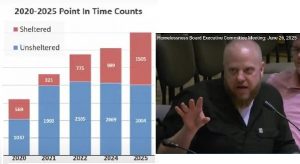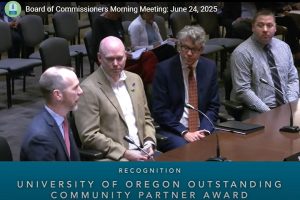LTD uses EmX crash data to improve safety
6 min read
After studying 121 collisions with EmX buses, the Lane Transit District concluded that after 15 years, local drivers still don’t know how to use the Bus And Turn (BAT) lanes. On Dec. 14, the LTD board heard about a $2 million project for safety improvements.
[00:00:18] Randi Staudinger (LTD project manager): LTD was one of the first transit agencies in the country to implement a bus rapid transit system. That was in 2007 when we built the Franklin EmX corridor that connected Eugene Station to Springfield Station. In 2011, LTD expanded the bus rapid transit system and opened the Gateway EmX corridor, and that connected Springfield Station up to the International Way area.
[00:00:41] And then finally in 2017, we opened the West Eugene EmX corridor, which everyone remembers which connected the community all the way out west to Target and Walmart on West 11th. So together we have about 20 miles of a bus rapid transit system.
[00:00:54] Our bus rapid transit system, it’s been branded the EmX (Emerald Express) system, and it has dedicated bus lanes. It has shared business access and transit lanes, which we call BAT lanes, and it has traffic signal priority. These components prioritize transit, which allow our buses to provide continuous reliable service, but it also allows access into the businesses from normal pedestrian vehicles.
[00:01:17] We have a group of professional drivers that have learned the ins and outs of this system, but we have one safety issue that continues to stick out throughout all of Springfield and Eugene in our EmX corridors. And that’s the confusion that passenger vehicles have in utilizing the BAT lanes.
[00:01:32] Between 2017 and mid-2021, we had 249 incidents along the EmX route. Of these 249 incidents, there was 121 collisions which involved an EmX bus. And then we also had 44 near-miss events, which resulted in hard braking events. So the purpose of this project is to address these safety concerns that are happening out there.
[00:01:55] John Q: The EmX bus is 63 feet long and weighs more than 20 tons.
[00:02:00] Randi Staudinger: Those areas, when an accident happens, they’re pretty severe. It’s not just a little bump.
[00:02:06] John Q: Randi said LTD convened a group of experts to evaluate the crash data.
[00:02:10] Randi Staudinger: We got a big group of people together. We got our accident route review committee, which has drivers and union members involved in that committee. We had folks from our operations team. We got the City of Eugene traffic engineers, the City of Springfield traffic engineers, and then we got our consultant team, which consisted of PIVOT Architecture, WSP, which is a civil engineer, and DKS, which is a traffic engineer.
[00:02:34] We already had quite a bit of data compiled and we have accidents occurring everywhere out on the EmX route.
[00:02:40] John Q: It’s not entirely the local drivers’ fault. As the first such bus rapid transit system in the nation, the EmX system made a lot of mistakes.
[00:02:52] Randi Staudinger: There’s mixed messaging out there. On the pavement it says ‘Bus only.’ And then there’s a sign next to it that says ‘Right lane bus and right turn only.’ So, mixed messaging for drivers on what they’re supposed to be doing in that specific area.
[00:03:03] Most of the BAT lanes also have a solid white line, which many people interpret as a ‘Do Not Cross.’ And so they’re not merging into that BAT lane in order to make their turn. And oftentimes the skip striping, which signals to most of us to merge into there, only occurs for a very short duration.
[00:03:20] John Q: Board president Caitlin Vargas expressed sympathy for the bus operators.
[00:03:24] Caitlin Vargas: As someone who lives in West Eugene, driving out West 11th, it’s rough. I feel really bad for operators. It’s hard to change that behavior, right? Like when you go on that right turn and, oh gosh, I’ve seen so many cars go in front of the bus. So, I think as a citizen I see the need and just really appreciate you addressing this for safety issues. So thank you for that.
[00:03:48] Jameson Auten (LTD CEO): (President Vargas), I just want to emphasize that point that you just made. When you talk to our operators, that’s one of the first things that they point out. They’re professional operators of the vehicle and other systems, but they really have to have a super-heightened awareness of what’s going on, from a defensive standpoint.
[00:04:06] Some of them position the vehicle different ways. Some of them use audio to make sure that they’re aware and still things happen. And this is something that’s top-of-mind with our operators.
[00:04:16] John Q: Better traffic signage, lane striping, and red pavement will improve safety.
[00:04:22] Randi Staudinger: System-wide…the solution is to implement skip striping for the first two-thirds of a block to emphasize vehicle permissions to enter the BAT lane for making their turn maneuver. The skip striping would then turn into a solid white striping towards the end of that block to say, ‘Hey, you know, your opportunity to merge into this lane is over.’
[00:04:40] We’ll also install arrow markings, and then signage will be replaced and it’ll be made consistent through all of Springfield and Eugene, and it’ll emphasize vehicle permissions first with bus exception second.
[00:04:52] There’s two different types of signs. One will say, ‘Right lane must turn right except bus,’ or there’s a ‘Right Turn Right Only,’ and then ‘Except bus.’ So again, the emphasis is to really promote people to use these as a turn lane. So that’s what they’re there for.
[00:05:05] John Q: Randi described a number of system hotspots.
[00:05:08] Randi Staudinger: A really high hotspot that we have over on 6th Ave and Garfield. …Ferry Street is another example of a hotspot area we have. …Franklin and East 13th is another hotspot we have really similar to just nearby on Orchard and Franklin…
[00:05:22] And then lastly, a complaint that we heard from the drivers is that they just have a lot of inconsistency as far as what they’re supposed to be looking at when they’re at an intersection, whether it’s a transit signal or the red-green-yellow light. Not all of our signals have a transit signal. So we’ll be adding a transit signal.
[00:05:38] So there’s a lot of changes to be implemented here. But the goal is consistency and improved ease of use for all our drivers and to decrease the amount of accidents that are happening out on the EmX systems.
[00:05:48] In summary, it’s been a great collaboration. We’ve had a lot of folks at LTD involved. We’ve had both of the cities involved, and our engineers involved. So we’ve really been able to dig down into what’s going on out in the system and how we think we can effectively address it.
[00:06:02] John Q: A question from LTD board member Don Nordin.
[00:06:05] Don Nordin (LTD board): I don’t know what the schedule is, but isn’t Franklin there at Dads’ Gates (Yeah) going to be totally rebuilt. (It will.) So is that going to coincide with Brown Engineering’s work on the Dads’ Gates area?
[00:06:18] Randi Staudinger: So what we’re going to be doing there—so, we talked about like the Orchard and Franklin, East 13th and Franklin, the red pavement marking. So yes, we will be spending the money to put red paint application and do some radar detection there, and it will get removed when the Franklin Boulevard project happens. But we’ve talked about it and we think it’s worth the investment for the severe impacts that those accidents cause.
[00:06:40] Caitlin Vargas (LTD board): Thank you, Randi. What type of public marketing will we be doing with the community to help them understand these changes?
[00:06:48] Randi Staudinger: Yeah, so their actual driving behaviors, like what, how they’re going to utilize the BAT lanes, it doesn’t change from how they utilize them now or how it’s recommended. It’s just the visual cues that will be given will change.
[00:07:00] John Q: LTD uses crash data to improve safety for the pioneering bus rapid transit system. EmX costs another $2 million, even as many local residents are starting to ask critical questions.





